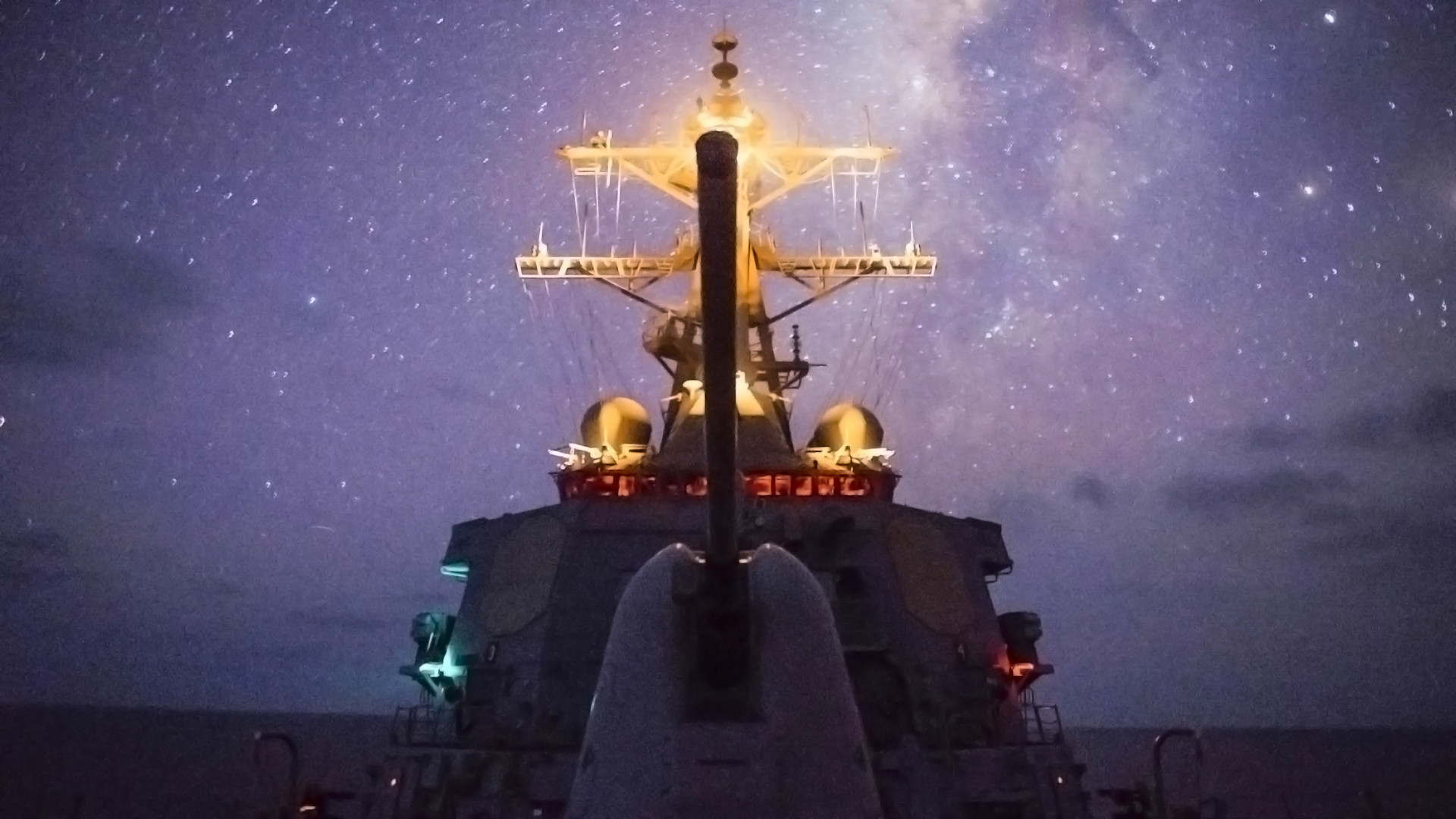The U.S. Navy has released 35 brief reports regarding various incidents involving its ships and facilities and unidentified small uncrewed aircraft systems, or sUASs, across the entire span of the Pacific between 2016 and 2021. Not all of the reports appear to be notable, and some are clearly innocuous, but others absolutely provide additional evidence of concerning trends that The War Zone has been actively reporting on in recent years. Among the newly released reports, for instance, is one that covers a worrying encounter that the Arleigh Burke class destroyer USS Paul Hamilton had with four drones in the Pacific off the coast of southern California in 2019, which you can read more about in our past reporting here.
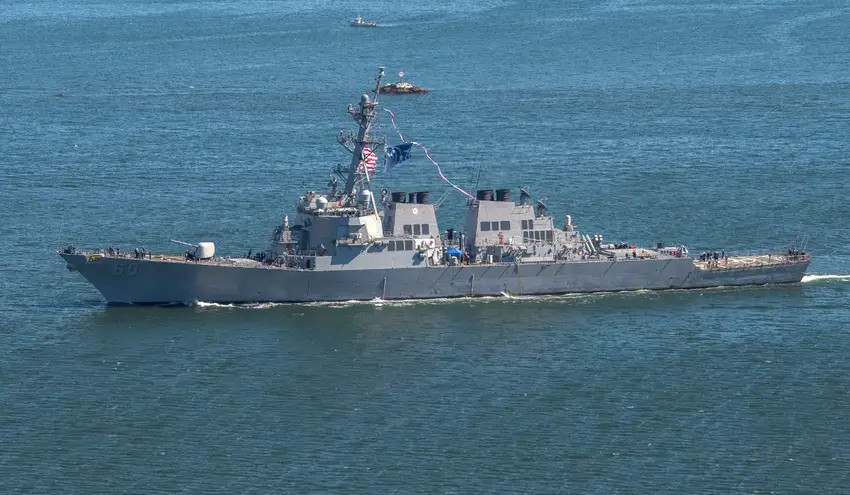
The War Zone obtained these records in response to a Freedom of Information Act (FOIA) request to the U.S. Navy’s Pacific Fleet (PACFLT) for UAS incident reports made through the OPREP-3 reporting system between 2017 and April 22, 2021. The reports that the Navy released, which may include one incident that occurred in 2016, are all unclassified and only have privacy-related redactions. PACFLT withheld in full another 116 reports that it found, but said were classified.
The 35 released reports all cover what are described as encounters with “Unmanned Aircraft System/Non Traditional Aviation Technology (UAS/NTAT).” NTAT appears to be a term predominantly used by the Department of Homeland Security, rather than the Department of Defense. None of them mention unidentified flying objects (UFO) or unidentified aerial phenomena (UAP), the latter of which is the U.S. military’s current preferred term for such things. There do not appear to be any descriptions of extreme performance or otherwise unexplainable capabilities contained within them, either.
As already noted, an incident involving the USS Paul Hamilton on the night of July 30-31, 2019, is included among the reports. This was one of a series of drone swarm encounters that the crews of multiple Navy vessels reported while operating in the vicinity of California’s Channel Islands off the coast of San Diego that year. The War Zone has reported extensively on these incidents based on previous FOIA requests and other information and materials the Navy has released.
This newly released report says the following about that encounter:
PHM [USS Paul Hamilton] observed four UASs with a CPA [closest point of approach] approximately 200 yds off the bow, port and starboard beams. The UASs had an on station time of approximately 2 hours and 20 minutes. The first UAS was spotted by lookouts at 0240L. observed with a single, solid white light off the port bow. At 0326L as PHM turned to course 180T, a second UAS was observed flashing the bow and bridge of PHM with what appeared to be a searchlight or photographic device. UAS closed to within 500 yds of PHM, repeatedly maneuvering aft to fwd. At 0330L, a UAS with four white lights and a flashing red light hovered approximately 200 yds above PHM and maneuvered from aft to forward. At 0332L, another UAS hovered with no lights approximately 300-500 yds off the bow of PHM and once again shined the bow and bridge with what appeared to be a searchlight or photographic device. PHM proceeded east after which the UAS maneuvered to match PHM course and speed, before departing the area to PHM’s port side. UASs sighted in immediate vicinity of PHM from 0240L until 0530L. Point of origin of all UASs is unknown. UASs were observed visually, with optical sighting system, and night vision goggles. Three UASs were identified visually as quadcopters.
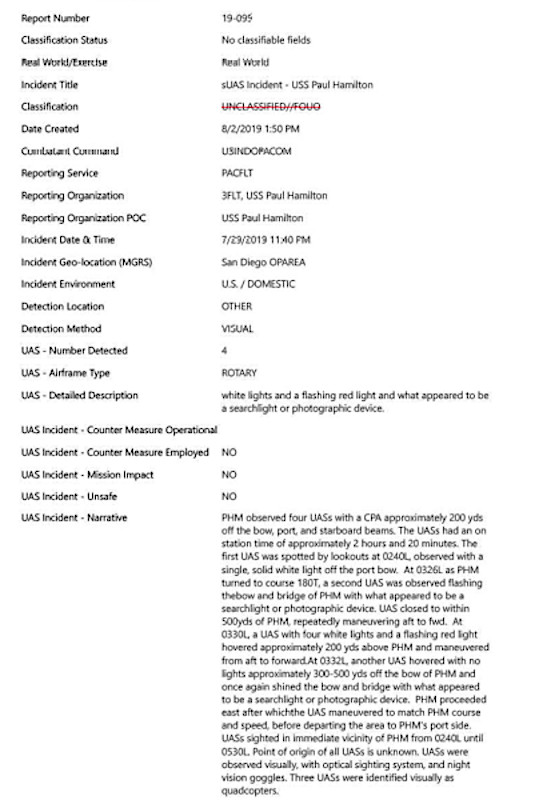
Much of this is in line with details that have already emerged about this incident, notably that drones were positively identified by the destroyer visually and by using other sensors. However, that these drones flashed or shined “a searchlight or photographic device” at the ship’s bow and bridge multiple times is a new piece of information. It’s unclear what might have happened, but it is certainly another sign that the UASs could have been engaged in some kind of surveillance or intelligence-gathering activity.
It’s also interesting that despite all of this, no countermeasures were employed and the Navy determined that there was no impact on the ship’s ability to perform its assigned missions or operate safely.
The video below of an unidentified drone was taken by personnel onboard the USS Paul Hamilton in July 2019.

Four more reports cover separate incidents that occurred in or around the Chinese port city of Hong Kong. Of these, the report of an encounter that the Arleigh Burke class destroyer USS Chafee had with two unidentified drones while sailing into the city’s main port on October 2, 2017, is by far the most interesting. The narrative section of the report reads as follows:
BLUF [Bottom Line Up Front]: At approximately 1/2000W (2/1400LOCAL) OCT, upon entering port in Hong Kong, USS CHAFEE was approached by 2x UAS The following is based upon initial voice report by C7F BWC [Commander, U.S. 7th Fleet Battle Watch Captain] to CPF [Commander, U.S. Pacific Fleet] (2/0225W OCT 17): -One UAS landed on CHAFEE and was secured by ship’s force -The second UAS flew away from the vicinity of the ship -AMEMBASSY [American Embassy; an apparent reference to the U.S. Consulate General in] Hong Kong advised CHAFEE to maintain custody of the UAS to be turned over to NCIS [Naval Criminal Investigative Service] team upon arrival – ETA: 2/1700W (3/1000LOCAL) OCT Voice report relayed to PACOM JOC [U.S. Pacific Command Joint Operations Center] upon receipt.
P 030005Z OCT 17 FM USS CHAFEE MSGID/OPREP-3,USMTF,2005/CHAFEE/024// REF/A/DESC:INITIAL REPORT TO ISIC/CHAFEE/021015ZOCT17// REF/B/DOC/OPNAV/04OCT2011 // NARR/REF A INITIAL VOICE REPORT TO ISIC. REF B IS OPNAV INSlRUCTION F3100.6J CH-2.// FLAGWORD/OPREP 3, NAVY UNIT SITREP/-// TIMELOC/020947ZOCT2017 /2217N 11407E/INIT// GENTEXT/INCIDENT IDENTIFICATION AND DETAILS/ 1. INCIDENT: AIRBORNE SURVEILLANCE 2. DATE OF INCIDENT: 02OCT2017 3. TIME. OF INCIDENT: 1747 (INDIA TIME ZONE) 4. LOCATION OF INCIDENT: INPORT PORT SIDE TO CHINA MERCHANT WHARF HONG KONG, HK 5. SUMMARY /BRIEF DESCRIPTION: 1747 TWO QUAD COPTER DRONES OVERFLEW CHAFEE. ONE DRONE LANDED ON THE STBD [starboard] SIDE QUARTERDECK. SECOND DRONE SPOTTED FLYING OVER THE MAST ON THE PORT SIDE. 1759 SECOND DRONE DEPARTED ONCE THE FIRST DONE LANDED ON DECK. 1815 FIRST DRONE WAS CONFISCATED BY SHIPS FORCE. AND SD CARD REMOVED. THE DRONE HAS BE SECURED IN A LOCKED SPACE. 1945 NCIS NOTIFIED AND Will ARRIVE 03OCT17 TO RETRlEVE THE DRONE. 6. MEDIA INTEREST: NOT ANTICIPATED 7. COMMANDER’S ASSESSMENT: ABLE TO CONTINUE PRESENT MISSION. FINAL REPORT THIS INCIDENT.

Needless to say, the fact that one of the drones in this incident actually landed on the ship’s deck is both extremely interesting — especially since it does not appear to have been disclosed before now — and potentially concerning. As The War Zone has explored in depth in the past, even a small commercial quadcopter-type drone can be modified to carry munitions or other hazardous payloads. That the State Department [via the U.S. Consulate in Hong Kong] was looped in, underscores the potentially very sensitive nature of the whole event.
That this particular incident was formally categorized as “surveillance” of the ships is notable, as well. There is no further information provided as to what any subsequent investigations determined about the drone, or its companion, what they were doing, and what information they might have gathered. It’s also unclear whether or not authorities in Hong Kong or elsewhere in China were informed and/or made queries about this incident.
Details about the earliest of three remaining Hong Kong-related incidents are limited and the Navy ship that was involved is unnamed. Though the report was logged in 2017, the accompanying metadata suggests that it occurred in 2016, or was at least initially reported that year via NCIS’ Multiple Threat Alert Center (MTAC) in Quantico, Virginia.
“Quadcopter UAS appeared to be conducting possible surveillance of a DON [Department of the Navy] vessel during a port visit to HK [Hong Kong],” the brief accompanying narrative says. “UAS was observed on three different occasions to include the DON vessel’s arrival port call and departure.”
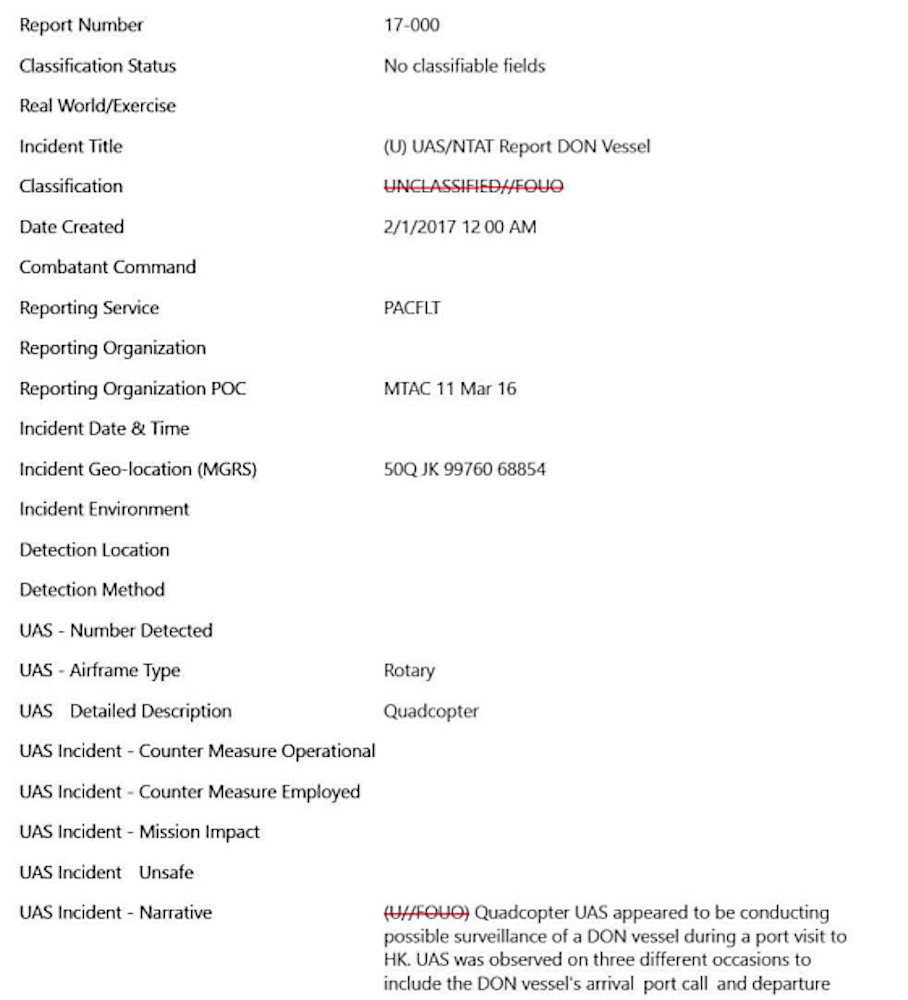
Far more information is available about encounters that the Wasp class amphibious assault ship USS Makin Island had with multiple drones near Hong Kong over a period of three days in April 2017. The narrative from that report, which came in part from details provided by a Ship Nautical Or Otherwise Photographic Interpretation and Exploitation (SNOOPIE) team on the ship, says:
06/1600W April 2017- SUAS WAS VID [visually identified] ON STARBOARD QUARTER OF MKI [USS Makin Island] AS MKI WAS ARRIVING AT ANCHORAGE IN HONK KONG. SUAS HOVERED APPROXIMATELY 100 YARDS OFF THE STARBOARD SIDE FOR 5 MINUTES AT THE SAME HEIGHT AS THE BRIDGE WING. SUAS PROCEEDED TO FLY DOWN THE STARBOARD SIDE OF THE SHIP BEFORE PASSING ASTERN AND TAKING POSITION OFF THE PORT SIDE. SUAS HOVERED FOR APPROXIMATELY 5 MINUTES BEFORE FLYING A RECIPROCAL PATH BACK TO THE STARBOARD SIDE OF MKI AND DEPARTED. MKI SNOOPIE TEAM LOST VID AT 1618W.
07/1800W April 2017- SUAS WAS VID ON PORT QUARTER OF MKI WHILE AT ANCHORAGE IN HONG KONG. AT APPROX. 0400Z, SUAS APPROACHED THE PORT BOW AND FLEW OVER SHIP TO STARBOARD AFT WITH AN ALTITUDE OF APPROX. 100FT ABOVE THE FLIGHT DECK (09 LEVEL), HOVERED NEAR AFT OF SHIP FOR APPROX. 1 MINUTE THEN PROCEEDED TOWARDS FISHERMAN’S WHARF. AT 0435Z, SECOND SIGHTING OF SUAS WAS SPOTTED STARBOARD SIDE BROW LEVEL, FRAME 20. SUAS HOVERED IN FRONT OF BROW FOR 2 MINUTES, THEN RAPIDLY ASCENDED TO APPROX. 500 FT. AGL THEN PROCEEDED TO FISHERMAN’S WHARF. THIRD SIGHTING AT 0449Z ATSTARBOARD SIDE, BROW LEVEL, FRAME 20; MOVED AFT OVER MAIN MAST, DESCENDED TO APPROX. 7FT ABOVE DECK LEVEL AFT, THEN DESCENDED OFF THE AFT END OF THE SHIP, POSSIBLY TOWARDS THE FAN TAIL, THEN PROCEEDED TOWARDS FISHERMAN’S WHARF. FOURTH SIGHTING AT 0548Z, SUAS CIRCLED MKI FROMPORT AFT TO FORWARD THEN BACK STARBOARD AFT, THEN PROCEEDED BACK TO FISHERMAN’S WHARF. SUAS DESCRIPTION: BLACK, QUAD COPTER, NO DISTINGUISHING MARKINGS, 12-18″ IN DIAMETER, MADE A LOUD BUZZING SOUND.
08/1700- 2359W April 2017- MULTIPLE QUADCOPTER SUAS FLEW AROUND MKI FROM 1100 TO SUNSET. SUAS WERE APPROX. 100 FT. ABOVE THE FLIGHT DECK AS THEY CIRCLED MKI. SUAS DESCRIPTION: MULTIPLE QUADCOPTERS OF VARIOUS MODELS AND COLORS ALL SUAS MADE A LOUD BUZZING SOUND.
08/1800-2100W- SUAS FLEW AROUND MKI JUST AS IT DID ON 08APR17. SUAS WAS VID ON PORT QUARTER OF MKI WHILE AT ANCHORAGE IN HONG KONG. AT APPROX. 1730W, TOPSIDE ROVER REPORTED A WHITE SUAS THAT PASSED AROUND MKI AT APPROX. 100FT ABOVE THE FLIGHT DECK. IT MADE MULTIPLE CIRCLES AROUND MKI. SUAS DESCRIPTION: WHITE, QUAD COPTER, NO DISTINGUISHING MARKINGS, 12-18″ IN DIAMETER, MADE A LOUD BUZZING SOUND.

The Nimitz class aircraft carrier USS Ronald Reagan encountered multiple drones on October 3, 2017, around its port visit to Hong Kong, as well. The incident report in this instance says:
All times are in Hong Kong Time (HKT). AT APPROXIMATELY 0630-0635, SUAS OBSERVED AT APPROXIMATELY 350 OFF THE PORT BEAM, SUAS TRAVERSED BOW TO PORT BEAM AND THEN DEPARTED THE AREA.INCIDENT 2) AT APPROXIMATELY 0640-0642, A SECOND DRONE APPROACHED FROM 340 AND HOVERED APPROXIMATELY 500 FEET OFF PORT BOW AND THEN DEPARTED THE AREA.INCIDENT 3) AT APPROXIMATELY 0730-0737, A THIRD DRONE WAS OBSERVED AT THE STBD BOW, TRAVERSED AFT AND HOVERED OVER THE FLIGHT DECK.INCIDENT 4) AT APPROXIMATELY 0748-0759, A FOURTH SUAS WAS OBSERVED OFF THE BOW AND TRAVERSED FORWARD TO AFT AND THEN BACK FORWARD BEFORE DEPARTING.INCIDENT 5) AT APPROXIMATELY 0752 0757, A FIFTH SUAS WAS OBSERVED OFF THE STERN OF THE RRN AND CIRCUMNAVIGATED THE SHIP TWO TIMES AND DEPARTED THE AREA.INCIDENT 6) AT APPROXIMATELY 0806- 0816, A SIXTH SUAS WAS OBSERVED CIRCUMNAVIGATING THE SHIP BEFORE DEPARTING.INCIDENT 7) AT APPROXIMATELY 0830 0835, A SEVENTH SUAS WAS OBSERVED AT 180 R, IT CIRCUMNAVIGATED THE SHIP AND DEPARTED. NO WEAPONS WERE OBSERVED. DURING INCIDENTS, MANEUVERING WAS SAFE AND APPEARED TO BE UTILIZING SUAS ORGANIC CAMERA SYSTEM TO OBSERVE THE SHIP WITH NO IMPACT TO REAGAN. REAGAN DID NOT APPEAR TO BE IN DANGER WHILE AT ANCHORAGE

Another one of the reports covers an incident on the other side of the Pacific on July 19, 2019, where NCIS agents questioned a Chinese national who had been flying a small drone in the vicinity of the Rainbow Bay Marina near Pearl Harbor on the island of Oahu. “The drone operator… stated that he had just finished visit[ing] the [USS] Arizona Memorial and decided to test out his new drone… [by taking] a view of the sailboats in Rainbow Bay Marina,” the report’s narrative indicates.
“Rainbow Bay Marine is on Federally owned property located outside the [Pearl Harbor] installation parameter [sic; perimeter],” it continues. “NCIS arrived on scene, conducted system background verifications and found no indications of suspicious activity. The drone operator willingly allowed NCIS agents to inspect and examine his possessions.”
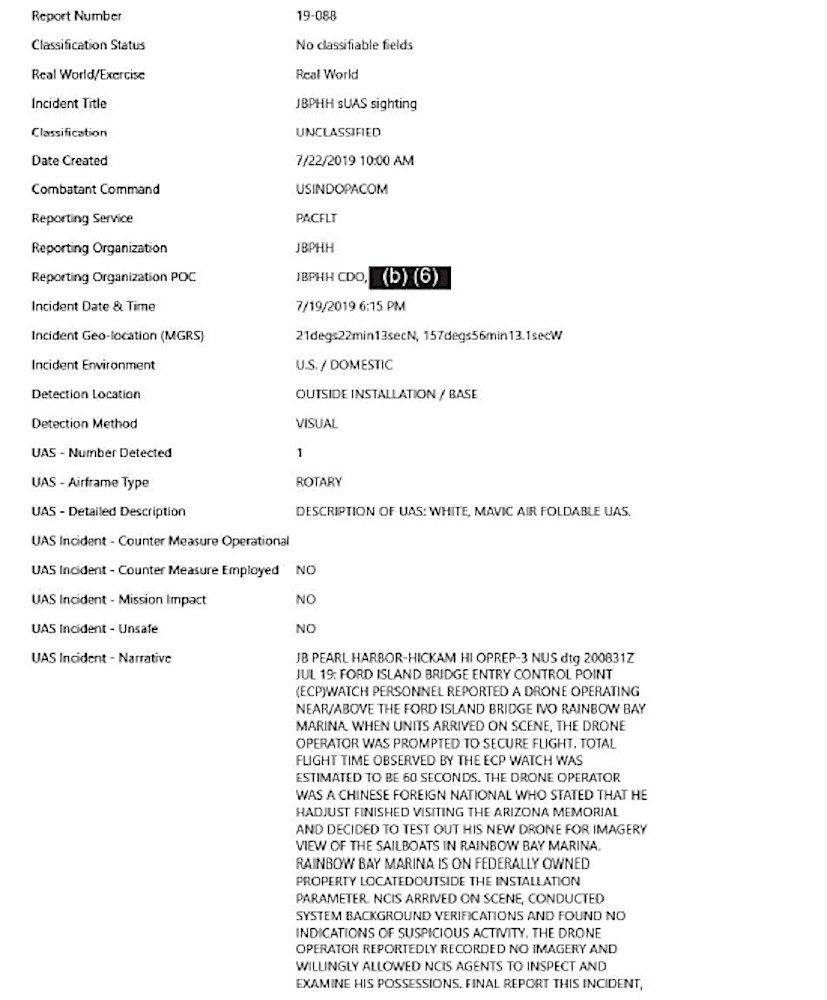
Though the report makes clear there were no indications in this incident of anything untoward, multiple ostensible Chinese tourists were arrested between 2018 and 2020 for trespassing on various Navy installations and for taking pictures of facilities therein. Those incidents led to prosecutions and convictions, and prompted discussions about potential coordinated Chinese espionage efforts leveraging private citizens abroad.
There are further Pearl Harbor-related incidents covered in the other reports. On at least three occasions the FBI was either subsequently involved directly in the investigation or was otherwise notified. This includes an incident on June 19, 2018, that saw the Bureau’s Joint Terrorism Task Force and NCIS interview an unidentified individual and confiscate their drone after they flew it into a perimeter fence.

Other incidents of obvious concern are among the reports, including one that occurred on the night of January 30-31, 2017, at the Navy’s base in Bangor, Washington, which is home to a number of Ohio class ballistic missile submarines and all three of the service’s secretive and highly specialized Seawolf class attack submarines, including the unique subvariant spy submarine USS Jimmy Carter, among other vessels. It is also the home of a major stockpile of the world’s most powerful nuclear warheads. The full narrative for this incident is as follows:
Marine Corps Security Forces Bangor initially spotted an Unmanned Aerial System (UAS) approaching from northwest of their position beyond the port security barrier between approximately 2300-0000W 30-31 January 2017. UAS flew at low altitude over Marginal pier, then continued southeast until no longer visible due to distance. According to eyewitness, the UAS turned off the external lights as it approached Marginal pier. UAS was reported as having a quad-copter body with a steady gold light and flashing red light At approximately 0145W, personnel reported UAS approaching from the Toandas area northwest of their position. UAS was reported at 500 ft above ground level or less in altitude, traveling at 10-15 mph, and was described as 4 steady white lights in a square pattern with a flashing red light A follow on observation occurred by Marine Corps Security Forces Bangor at approximately 031 SW. Initial observations reported UAS hovering over the port security barrier, in vicinity of buoy 14-16, before transiting southeast by marginal pier towards Explosives Handling Wharf (EHW)-1 and EHW-2. UAS then dropped in altitude in front of the waterside entrance to EHW-1, the UAS then gained altitude and flew south over EHW-2 before turning southeast at the northern end of marginal pier, and disappearing into the trees. A gunner aboard Marine Corps Security Forces Bangor described UAS as a quad-copter style UAS utilizing night vision goggles. Assessment of intentions is surveillance. There was no Persistent Ground Surveillance Tower (PGST) confirmation of the sighting. EHW operations were in progress during overflight.
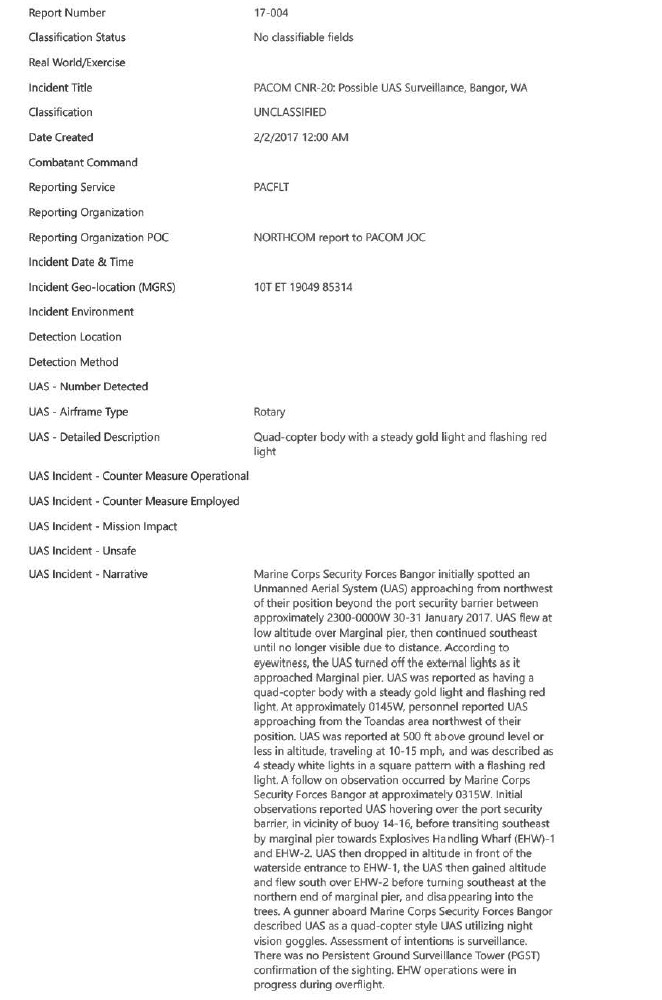
The fact that explosive-handling operations were being conducted at this portion of the facility during this apparent surveillance stands out in this report. Other drone incidents around this Navy base and other associated facilities that make up Naval Base Kitsap are included in these reports, some of which are also described as likely the result of surveillance. At least one incident prompted involvement by the FBI. Unidentified drone activity around these facilities has been publicly reported in the past, and many of those incidents have been downplayed by the service.
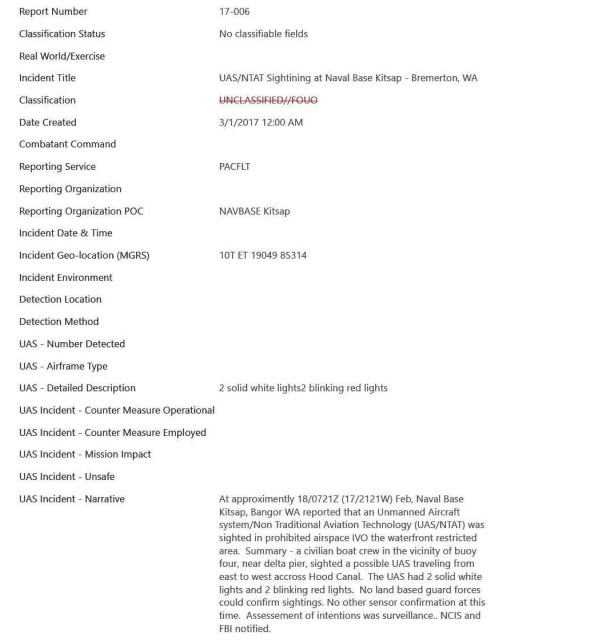
Another incident on August 2, 2019, saw a small drone fly within 300 feet of the Ticonderoga class cruiser USS Mobile Bay while the ship was visiting Seattle, Washington for a fleet week event. Interestingly, the ship’s crew was only alerted to the presence of the drone by engineers attending the event from Naval Air Systems Command (NAVAIR).
“Mobile Bay watch officer did not initially have visual on UAS. However, after refining UAS location with NavAir engineers Mobile Bay Watch Officer visually aquired [sic] UAS,” according to the report. “The UAS was seen hovering over a building and then landed out of sight. NavAir engineers agreed UAS was not a threat. No weapons were observed.”

Not all of the incidents in the reports involve drones operating very close to Navy ships. Also on August 2, 2019, the Avenger class mine countermeasures ship USS Patriot was sailing in the Philippine Sea when the crew spotted what appeared to be uncrewed aircraft flying at around 2,000 feet above the vessel.
The apparent drone was observed “moving from forward to aft. 40 min later contact made a second pass on starboard side from aft to forward,” the report’s narrative says. “Closest point of approach was approximately 2,000 yds. Unable to acquire imagery due to altitude, range, and low light.”
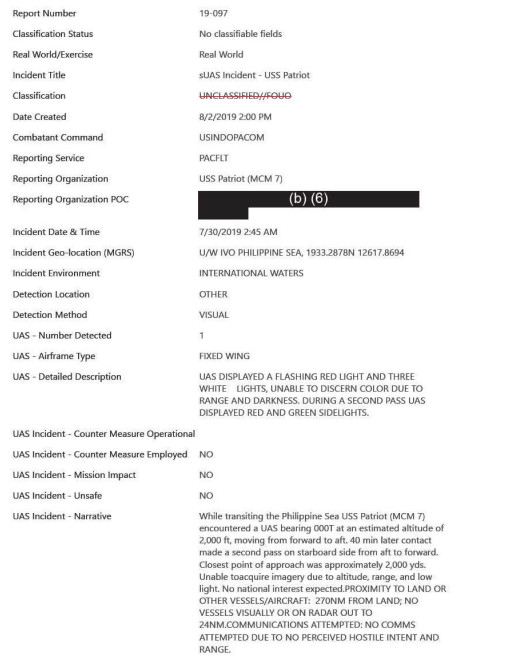
Some of the reports mention that counter-drone countermeasures were available and/or employed, but a specific system appears to only be identified by name on one occasion. During an incident at Naval Base Guam on July 6, 2020, a Drone Defender system was “on station” but was not employed because “the engagement did not meet the criteria,” according to the report in question.
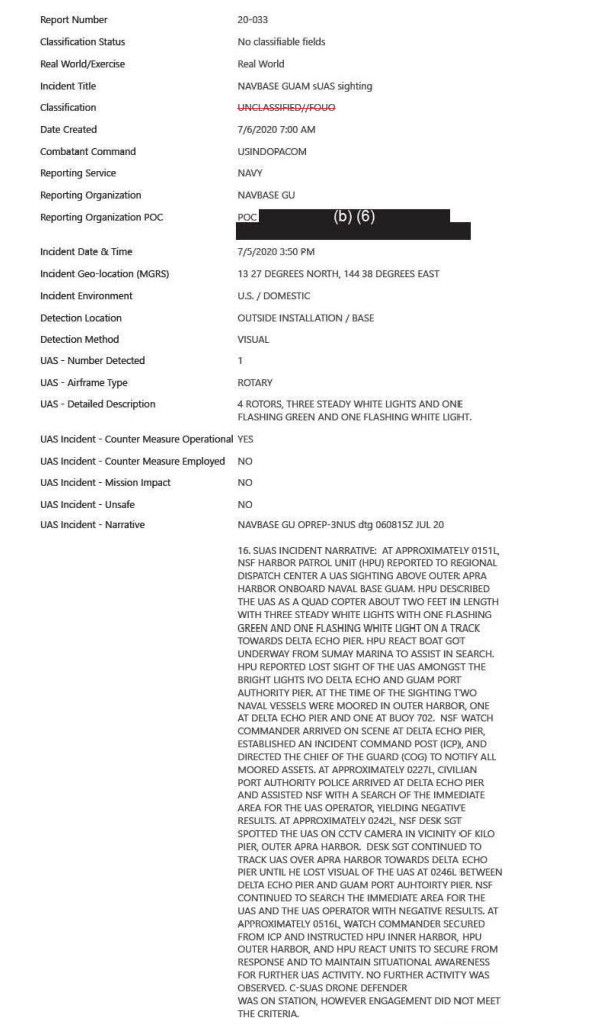
Interestingly, one of the reports regarding an incident at Pearl Harbor on August 17, 2018, specifically noted that at that time “no electronic C-sUAS [counter-small uncrewed aerial systems] capability exists at JBPHH [Joint Base Pearl Harbor-Hickam].”
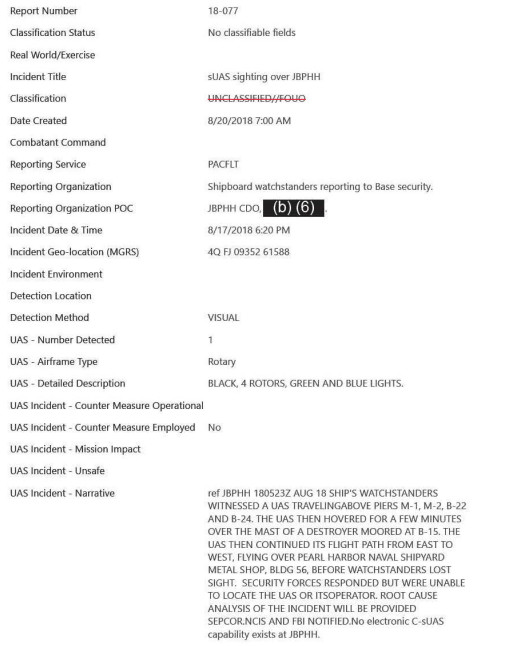
These are just some of the details contained in the 35 reports released. As already noted, some of the incidents, like an instance where an unidentified servicemember was caught flying a radio-controlled model airplane without the necessary prior approval from the base commander at Fleet Activities Yokosuka in Japan, appear entirely innocuous.
You can find copies of all 35 incident reports here.
As already noted, we know that these 35 reports do not encompass all of the drone incidents that the Navy’s Pacific Fleet recorded between 2017 and 2021. The War Zone plans to appeal the service’s determination that no part of the other 116 reports that it located could be released.
In addition, the reports appear to have been generated from U.S. Pacific Command’s (now U.S. Indo-Pacific Command) database, rather than a Navy one. The numbering scheme of the reports indicates that there are far more than 151 incidents in this “sUAS Incident Data Base,” suggesting that it could contain ones involving other branches of the U.S. military, as well.

Other services have definitely reported drone incidents in the Pacific region that are not included in these newly released reports. For instance, The War Zone was the first to report on other worrisome drone incidents that occurred at the U.S. Air Force’s Andersen Air Force Base on Guam in 2019 and that saw multiple drones fly over the U.S. Army-operated Terminal High Altitude Area Defense (THAAD) battery there.
In addition, it is well-established that the U.S. military, as well as other U.S. government agencies, have recorded various encounters with unidentified drones, some of which have been very concerning outside of the Pacific region. The War Zone previously obtained reports via FOIA or otherwise reported on Navy and Air Force encounters along the East Coast of the United State, among other places, as well as domestic incidents related to non-military infrastructure. We have even put together a publicly accessible database of domestic incidents recorded by the Federal Aviation Administration (FAA).
The 35 newly released reports do not have the same degree of granularity in their details, either. The reports are all compiled using a standard incident form, but in some cases certain fields, such as ones that are supposed to say whether or not countermeasures were employed or if the interactions were judged to be unsafe, have simply been left empty. Things like “UAS Incident – Counter Measure Employed” and “UAS Incident – Unsafe” appear in all of the reports, but they do not automatically mean those things are true. Something like “Yes”/”Y” or “No”/”N,” or even “N/A,” is clearly supposed to be inputted in the adjacent field in the form.
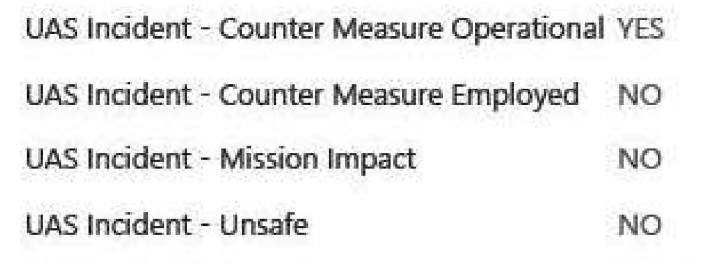
Regardless, the reports the Navy has released underscore that drone encounters have become commonplace and that some of them may in fact be efforts by adversaries or potential adversaries to spy on, surveil, or otherwise harass American forces at home and abroad. The reports also highlight the challenges U.S. forces have faced in responding to these incidents.
The War Zone has repeatedly highlighted how this kind of potentially hostile activity is responsible for some of the reported UFO/UAP sightings, as you can read more about in this past feature. We have also noted how the U.S. military, as well as other U.S. government organizations, are still largely playing catchup when it comes to fielding counter-drone capabilities and developing the tactics, techniques, and procedures for how and when to employ them, especially in response to domestic incidents.
The War Zone is still planning to take a deeper dive into the 35 reports the Navy has now released to see what other significant details may be contained within them.
Special thanks to The War Zone contributors Marc Cecotti and Adam Kehoe who obtained these Navy drone incident reports and assisted with this story.
Contact the author: joe@thedrive.com
